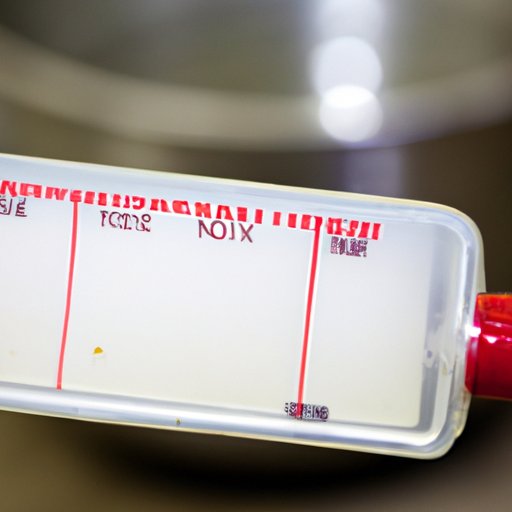Introduction
Many recipes call for ingredients to be measured in milliliters or grams. However, the conversion from milliliters to grams can be a common problem for home cooks and bakers alike. Knowing the correct conversion can make the difference between a perfectly baked cake and a flop. In this article, we’ll provide a comprehensive guide for converting milliliters to grams accurately in cooking and baking.
Understanding the Relationship between Milliliters and Grams: A Comprehensive Guide
Milliliters and grams are both units of measurement, but they measure different things. Milliliters measure volume, whereas grams measure weight. For liquids like water or milk, milliliters are often used to measure the volume of the ingredient. When it comes to dry ingredients like flour, sugar, or salt, grams are used to measure the weight of the ingredient.
It’s important to understand the relationship between milliliters and grams to convert between the two units of measurement accurately. The conversion rate from milliliters to grams will depend on the density of the ingredient. Dense ingredients like honey or syrup will weigh more in grams than a less dense ingredient like water.
Knowing the conversion rate is important for cooking and baking because accurate measurements are critical to achieving the desired result. Too much or too little of an ingredient can affect the texture, taste, and overall success of a recipe.
Converting Liquid Measurements to Weight: How Many Grams Are in Milliliters?
To convert milliliters to grams, we need to know the density of the ingredient to be measured. The formula for converting milliliters to grams is:
Grams = Milliliters x Density
For example, to convert 50 milliliters of honey to grams:
Grams = 50 x 1.42 (density of honey) = 71 grams
Here are some common liquid ingredients and their corresponding weight in grams:
– 1 milliliter of water = 1 gram
– 1 milliliter of milk = 1.03 grams
– 1 milliliter of vegetable oil = 0.92 grams
– 1 milliliter of honey = 1.42 grams
– 1 milliliter of maple syrup = 1.35 grams
The Simple Guide to Converting Milliliters to Grams for Accurate Measurements
Converting milliliters to grams can be tricky, but with a few simple steps, it can be done accurately. Here’s a step-by-step process for converting milliliters to grams:
1. Determine the ingredient to be measured and its density.
2. Use the formula: Grams = Milliliters x Density.
3. Multiply the volume of milliliters by the density of the ingredient to find the weight in grams.
For example, to convert 100 milliliters of vegetable oil to grams:
1. Determine the density of vegetable oil, which is 0.92 grams per milliliter.
2. Use the formula: Grams = 100 x 0.92 = 92 grams.
Mastering Milliliters and Grams: A Quick Guide for Home Bakers
Accurate measurement is essential in baking because it affects the texture, rise, and overall quality of the baked good. Here are some tips for successful baking using milliliters and grams:
1. Use a kitchen scale for more accurate measurements.
2. Properly spoon flour into the measuring cup and level it off.
3. Aerate the flour before measuring to avoid compacting.
4. Use weight measurements for accuracy.
Measuring Precisely: How to Convert Milliliters to Grams for Perfect Recipes
Precision in cooking is critical to achieving the desired outcome. Here are some tips for converting milliliters to grams accurately:
1. Always measure ingredients accurately.
2. Use a kitchen scale for precise measurements.
3. Check the density of the ingredient to ensure correct conversion.
From Milliliters to Grams: Why It’s Important to Know the Conversion
Inaccurate measurements can lead to disastrous results in cooking and baking. Too much or too little of an ingredient can change the texture, rise, and overall flavor of the recipe. It’s important to know the conversion from milliliters to grams for successful cooking and baking.
The Ultimate Cheat Sheet for Converting Milliliters to Grams in Cooking and Baking
Here’s a practical guide to converting milliliters to grams for common ingredients:
– Water: 1 milliliter = 1 gram
– Milk: 1 milliliter = 1.03 grams
– Vegetable Oil: 1 milliliter = 0.92 grams
– Sugar: 1 milliliter = 0.85 grams
– Flour: 1 milliliter = 0.53 grams
Conclusion
Converting milliliters to grams accurately is essential to the success of cooking and baking. By following the conversion formula and using a kitchen scale, home cooks and bakers can achieve precise measurements for perfect recipes. Remember to check the density of the ingredient and measure accurately to avoid disastrous results in your kitchen.
